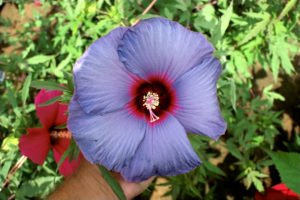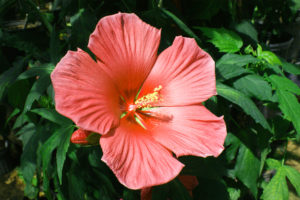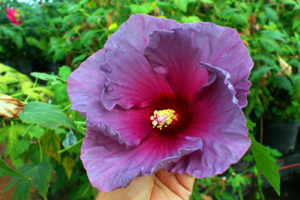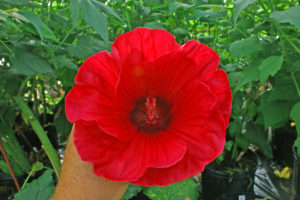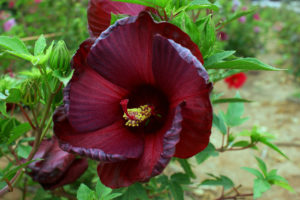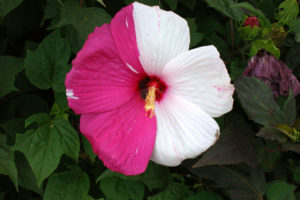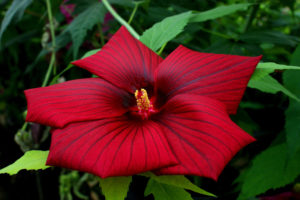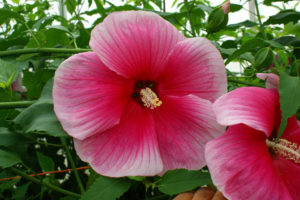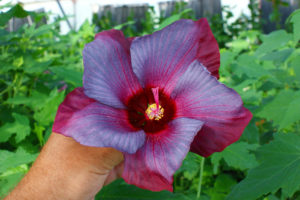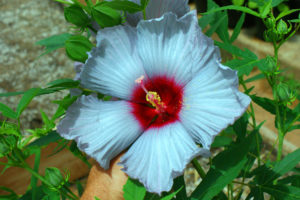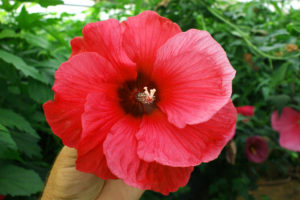Farm & Ranch
AgriLife Researcher develops a painter’s palette of winter-hardy hibiscus colors
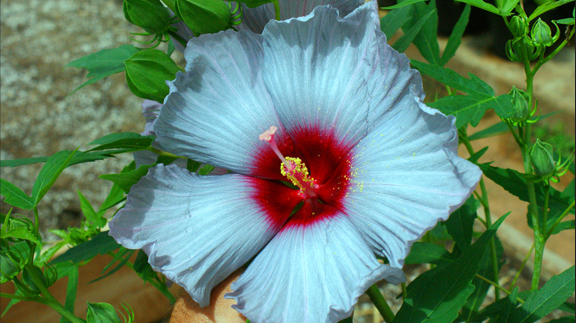
By: Kay Ledbetter
Writer: Kay Ledbetter, 806-677-5608, [email protected]
Contact: Dr. Dariusz Malinowski, 940-552-9941, [email protected]
Steve Brown, 940-552-6226, [email protected]
VERNON – Like an artist using the paint on a palette, Dr. Dariusz Malinowski is mixing pollen to create a flowering masterpiece in the form of tropically colored winter-hardy hibiscus.
Three years after the Texas A&M AgriLife Research breeding team at Vernon created the first blue-flowering winter-hardy hibiscus, they have come up with a new salmon-colored garden jewel, Malinowski said.
“In the past six years, we have disclosed to the Texas A&M University System Office of Technology and Commercialization more than 180 unique lines of winter-hardy hibiscus with very unusual flower and leaf color and shape,” he said.
With his two colleagues, Dr. William Pinchak, AgriLife Research animal nutritionist, and Steve Brown, Texas Foundation Seed Service program director, both based in Vernon, Malinowski continuously works on creating new colors in winter-hardy hibiscus.
“Until a few years ago, these beautiful flowers were available only in white, pink and red,” Malinowski said. “The introduction of a purple color in the cultivar ‘Plum Crazy’ by Flemings Brothers in 1999 was an important progress in the winter-hardy hibiscus breeding.”
He said in contrast to the tropical hibiscus, its distant relative, the winter-hardy hibiscus has a very narrow genetic potential for new colors to appear in the process of selective breeding. One reason is the relatively short time breeders have been attempting to create new flower colors compared to the efforts and time put into developing new color combinations in tropical hibiscus.
The late Georgia Bost, a passionate gardener who collected numerous winter-hardy hibiscus species and developed several new cultivars on her Hibiscus Hill Plantation at Waller, was the first to believe that extensive hybridization among available winter-hardy hibiscus species would eventually result in creation of new colors similar to those in tropical hibiscus, Malinowski said.
“We also believe in this theory and have created to date over 8,000 hybrids among the four native species: H. coccineus, H. dasyacalyx, H. militaris and H. moscheutos, resulting not only in the most illusional blue-flowering hibiscus, but also numerous other colors, including maroon, magenta, dual-colored flowers and the newest with salmon-colored flowers,” he said.
Released to date are the Blue Angel, the first blue-flowering hibiscus cultivar, and the Robert Brown, a chimera, a hybrid where both parental genomes do not fuse completely and work independently to some extent, providing an unpredictable dual-color pattern of the flower. Blue Angel was released in memory of The Blue Angels, the U.S. Navy’s flight demonstration squadron, and Robert Brown was released in memory of Brown’s son, Robert B. Brown.
The salmon color is the third breakthrough in their winter-hardy hibiscus breeding, after the blue and purple colors developed a few years ago, Malinowski said.
However, he said, the program has created a number of unique colors, including all shades of pink, magenta, red, crimson, purple, blue, lavender and maroon.
“Interestingly, some of our winter-hardy hibiscus hybrids started to resemble tropical hibiscuses, both with flower shapes and color combinations,” Malinowski said. “The most unusual hybrid resembles a hollyhock when in bloom.
“Our next goal is to develop yellow and orange colors in winter-hardy hibiscus, and the salmon color is the first step in the right direction,” he said. “There are two cultivars on the market with the name ‘yellow’ in them, but their flower color has nothing to do with yellow, maybe a cream color at best.”
Malinowski said the AgriLife Research breeding team expects to achieve the new colors in the next few years.
“It took us only three years to come up with the blue color, and at that time I was very skeptical if that was even possible, because blue color did not exist in winter-hardy hibiscus. I am positive we will eventually create an orange-flowering hibiscus,” he said.
The winter-hardy hibiscus breeding program at Vernon has been recognized worldwide by breeders and commercial nurseries. The flowers can basically be grown from South Central Texas to Canada, as long as the required winter period is long enough for them to go dormant after the first frost, Malinowski said. The plants resprout from the root the following spring.
“We, the hibiscus breeders, are very well organized and can share new information in a matter of minutes, thanks to the Internet,” he said. “Such an informal collaboration helps the program to be known and focus on breeding goals commonly sought by others.”
Brown said several companies are evaluating different materials for commercialization across the U.S. All of these lines are vegetatively propagated; in other words the commercial plants come from cuttings rather than seed.
“Once these companies decide they wish to include these lines in their product offering, they will license the products, and propagate to begin to increase their numbers,” he said.
Most of the very large ornamental companies have divisions dedicated to the propagation of large numbers of “liners” or small plants from cuttings, Brown said. These companies will then sell the liners to commercial nurseries that in turn will plant them in pots used for commercial sales in big box stores or retail garden centers.
This process, once a nursery makes the decision to commercialize a new product, takes about two to three years before the consumer will see the product in the garden centers in great numbers over a diverse area, he said.
-30-
Find more stories, photos, videos and audio at http://today.agrilife.org
Farm & Ranch
Hazards of Backyard Poultry

By Barry Whitworth, DVM
Having backyard poultry is a popular agriculture enterprise. According to the United States Department of Agriculture, 0.8 percent of all households in the United States have chickens. People keep chickens for a variety of reasons with table eggs being one of the more common reasons.
Unfortunately, some of these poultry producers are not aware of the hazards that come with keeping poultry because many times they carry pathogens but appear healthy.
Chickens are carriers of several zoonotic diseases. These are diseases that can be passed from animals to humans. According to a recent survey in Pennsylvania, a majority of backyard poultry producers were aware of the dangers of avian influenza. However, this study also revealed that far fewer producers were aware of the risk of possible exposure to Salmonella and Campylobacter.
The lack of knowledge about the hazards of raising poultry likely contributes to the continued issues of Salmonella outbreaks associated with backyard poultry. In 2023, the Centers for Disease Control and Prevention reported 1,072 illnesses of Salmonella linked to backyard poultry, and 272 of those patients required hospitalization. Oklahoma reported 43 individuals with the disease.
To read more, pick up a copy of the April issue of NTFR magazine. To subscribe by mail, call 940-872-5922.
Farm & Ranch
Ag Elsewhere: Wyoming

By Tressa Lawrence
Babies are tucked away in every nook and cranny. Many ranchers across Wyoming have baby animals popping up all over this time of year.
Farm & Ranch
Ag Elsewhere: Montana

By Lindsey Monk
Another load of grain in to keep feeding the calves until the green grass can really start popping.
-

 Country Lifestyles1 year ago
Country Lifestyles1 year agoScott & Stacey Schumacher: A Growth Mindset
-

 Equine7 months ago
Equine7 months agoThe Will to Win
-

 Country Lifestyles7 years ago
Country Lifestyles7 years agoStyle Your Profile – What your style cowboy hat says about you and new trends in 2017
-

 Country Lifestyles4 years ago
Country Lifestyles4 years agoAmber Crawford, Breakaway Roper
-

 HOME7 years ago
HOME7 years agoGrazing North Texas – Wilman Lovegrass
-

 Country Lifestyles7 years ago
Country Lifestyles7 years agoDecember 2016 Profile, Rusty Riddle – The Riddle Way
-

 Country Lifestyles8 years ago
Country Lifestyles8 years agoJune 2016 Profile – The man behind the mic: Bob Tallman
-

 Outdoor9 years ago
Outdoor9 years agoButtercup or Primrose?

